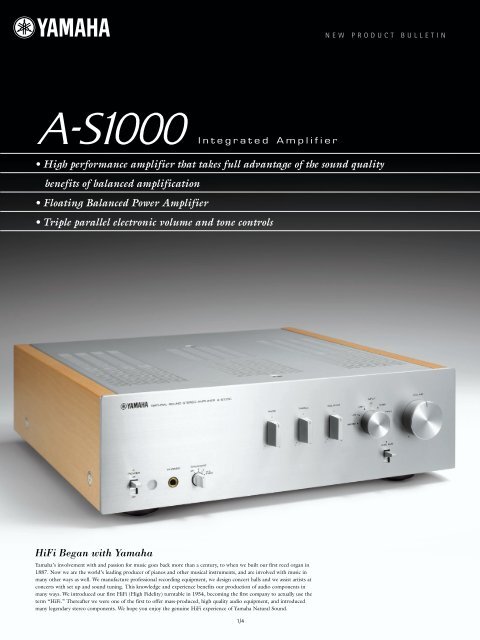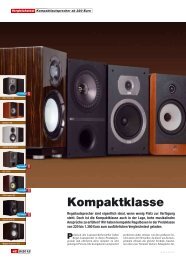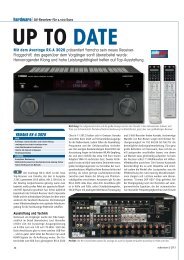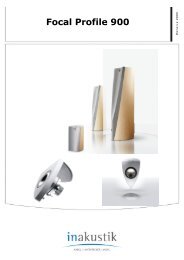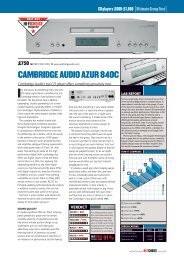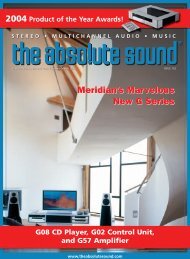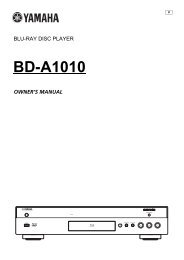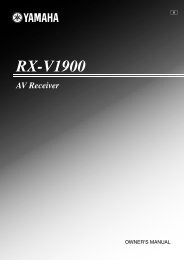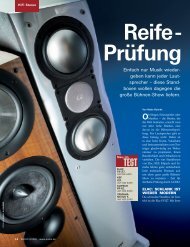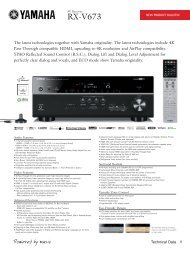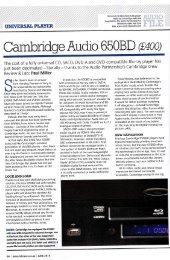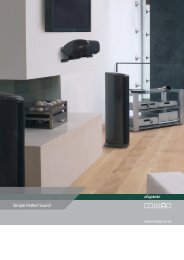Hifi Began with Yamaha - EXCELIA HIFI
Hifi Began with Yamaha - EXCELIA HIFI
Hifi Began with Yamaha - EXCELIA HIFI
You also want an ePaper? Increase the reach of your titles
YUMPU automatically turns print PDFs into web optimized ePapers that Google loves.
• High performance amplifier that takes full advantage of the sound quality<br />
benefits of balanced amplification<br />
• Floating Balanced Power Amplifier<br />
• Triple parallel electronic volume and tone controls<br />
HiFi <strong>Began</strong> <strong>with</strong> <strong>Yamaha</strong><br />
Integrated Amplifier<br />
<strong>Yamaha</strong>’s involvement <strong>with</strong> and passion for music goes back more than a century, to when we built our first reed organ in<br />
1887. Now we are the world’s leading producer of pianos and other musical instruments, and are involved <strong>with</strong> music in<br />
many other ways as well. We manufacture professional recording equipment, we design concert halls and we assist artists at<br />
concerts <strong>with</strong> set up and sound tuning. This knowledge and experience benefits our production of audio components in<br />
many ways. We introduced our first HiFi (High Fidelity) turntable in 1954, becoming the first company to actually use the<br />
term “HiFi.” Thereafter we were one of the first to offer mass-produced, high quality audio equipment, and introduced<br />
many legendary stereo components. We hope you enjoy the genuine HiFi experience of <strong>Yamaha</strong> Natural Sound.<br />
1/4<br />
NEW PRODUCT BULLETIN
NEW PRODUCT BULLETIN<br />
<strong>Yamaha</strong>’s All-New Approach to<br />
Achieving Superior Performance<br />
The development of the modern audio<br />
amplifier began in the 1960s <strong>with</strong> the<br />
introduction of full-transistor amplifiers. In<br />
the 1970s, pure complementary configured<br />
power amps appeared, made possible by high<br />
output PNP-NPN transistors, and became the<br />
dominant type of analogue amplifier. Now<br />
digital amps have become popular for their<br />
high conversion efficiency and superior<br />
operating precision, as well as for their lower<br />
weight, size and heat production as compared<br />
to analogue amps. Some manufacturers of<br />
audiophile-quality amps are working to<br />
improve the traditional pure complementary<br />
analogue amplifier, while others are seeking to<br />
achieve higher sound quality from digital<br />
amplifiers.<br />
But <strong>Yamaha</strong> has developed a third<br />
approach that we believe is superior to the<br />
other two. The Floating Balanced Power<br />
Amplifier features power transistors <strong>with</strong> the<br />
same polarity at the output stage to achieve<br />
completely symmetrical operation.<br />
First introduced in the A-S2000, this<br />
method is also used to good effect in the<br />
A-S1000, which combines a floating balanced<br />
power amp section <strong>with</strong> a high quality preamp<br />
section. Simpler in configuration yet <strong>with</strong><br />
many of the same sound quality features as<br />
the ultra high-end A-S2000, it will deliver<br />
excellent performance <strong>with</strong> the CD-S1000 Super<br />
Audio CD Player and other high quality<br />
components.<br />
High Performance Amplifier that<br />
Brings Out the Best of Other<br />
Components<br />
The power amp, power supply, and phono EQ<br />
circuits that contribute to the A-S1000’s high<br />
sound quality are identical to those of the<br />
A-S2000, while the line amp section and<br />
volume and tone circuits are nearly the same.<br />
Designed to take full advantage of the excellent<br />
sonic qualities of the matching CD-S1000, the<br />
A-S1000 will also bring out the best of other<br />
high performance components.<br />
Floating Balanced Power Amplifier<br />
With the A-S2000 and now the A-S1000,<br />
<strong>Yamaha</strong> has taken the bold step of using a<br />
floating balanced configuration to update the<br />
power amplifier for serious music fans. This<br />
method, which is completely different from the<br />
pure complementary circuit that has been the<br />
main type used for the past four decades,<br />
features identical polarity on the plus and minus<br />
side of the output stage. By completely isolating<br />
the plus and minus sides of the left and right<br />
channels of both the NFB and power supplies, it<br />
Integrated Amplifier<br />
The brilliantly expressive capabilities of <strong>Yamaha</strong>’s floating and balanced design<br />
— now available to a wider range of music lovers.<br />
2/4<br />
achieves perfectly symmetrical operation in the<br />
output stage. The use of four sets of floating<br />
power supply units (not connected to earth),<br />
provides further operating precision. The result<br />
is very low levels of noise and distortion for<br />
exceptionally pure and transparent sound<br />
quality.<br />
Conventional Power Amplifier<br />
Power amp and signal input and output are connected to ground<br />
+B<br />
Noise<br />
Ground wiring<br />
Feed back<br />
Noise enters power amp through ground<br />
Speaker<br />
A-S1000 Floating Balanced Power Amp<br />
Floating power supply<br />
Symmetrical<br />
+ –<br />
Speaker<br />
Feedback Feedback<br />
S Signal + S Signal –<br />
Ground wiring<br />
Power Supply<br />
Ground<br />
wiring<br />
Power Supply<br />
–B<br />
Floating power supply
NEW PRODUCT BULLETIN<br />
Triple Parallel Electronic Volume<br />
and Tone Controls<br />
Conventional audio amps have the volume<br />
and tone control circuits arranged in series<br />
(in line); when the tone controls are used, the<br />
signal route becomes more complicated,<br />
which can lower sound quality. Many high<br />
quality amps therefore have a default circuit<br />
that can be selected to bypass the tone<br />
controls, but this forces you to choose<br />
between tone control and optimum quality.<br />
The A-S2000 and A-S1000 are the first<br />
amplifiers to avoid this problem by employing<br />
triple parallel electronic volume and tone<br />
controls, providing maximum sound quality<br />
even when the tone controls are used (signal<br />
goes through fewer ICs, so there is less<br />
noise). When the tone controls are set to the<br />
center position, the passive element used for<br />
tone control is bypassed, so the three volume<br />
elements connected in parallel operate solely<br />
to drive and control the volume, for more<br />
efficient use of the power output. Each<br />
volume element is an ultra-high quality<br />
device and an analogue potentiometer is<br />
used to provide a very smooth operating feel.<br />
Fully Discrete Phono Equaliser<br />
and MC Head Amp<br />
The A-S1000 uses a fully discrete phono<br />
equaliser circuit, whose quality is comparable<br />
to those in high-end control amps. And <strong>with</strong><br />
Conventional Amplifier<br />
In<br />
Bypass<br />
Signal passes through two circuits increased noise<br />
A-S1000<br />
In<br />
Volume<br />
Volume<br />
Tone control circuit<br />
Bass / Treble<br />
+<br />
Bass<br />
Treble<br />
Signal passes through one circuit lower distortion, higher S/N ratio<br />
Flat<br />
+<br />
Out<br />
Out<br />
Completely symmetrical left-right construction. Large heat sink, huge power<br />
transformer, custom-made block<br />
capacitors (18,000µF) and preamp<br />
board.<br />
MC Head Amp and Equaliser Amp Block Diagram<br />
Lch In<br />
MM<br />
MC<br />
its high priority on maximising musical<br />
response, it is also equipped <strong>with</strong> a discrete<br />
head amp for MC cartridges. If you enjoy<br />
listening to records via high performance<br />
cartridges, the A-S1000 is an ideal choice.<br />
Power Supply<br />
+<br />
+<br />
MC Head Amp EQ Amp<br />
Power is provided by four large capacity<br />
power supplies that are completely isolated<br />
from earth. In the preamp stage, the<br />
combination of a low-current circuit that<br />
prevents the occurrence of noise due to<br />
current fluctuation and 12 shunt regulators<br />
supply all stages <strong>with</strong> clean and stable power.<br />
The extra-large power transformer, the<br />
carbon sheath block capacitors and other<br />
3/4<br />
Relay for Selecting<br />
MC Head Amp<br />
+<br />
+<br />
MM<br />
MC<br />
+<br />
+<br />
parts that directly affect sound quality were<br />
chosen only after extensive testing.<br />
Symmetrical Construction<br />
Although it is an integrated amplifier, the<br />
A-S1000 has a completely left-right<br />
symmetrical construction that makes it<br />
virtually the equal of separate amps.<br />
A central reinforcing bar ensures that the<br />
chassis is totally rigid.<br />
Specially Designed Feet<br />
Integrated Amplifier<br />
MC Head Amp +B<br />
EQ Amp +B<br />
Phono Out<br />
EQ Amp -B<br />
MC Head Amp -B<br />
The base is equipped <strong>with</strong> height adjustable,<br />
solid steel feet that maximise stability and<br />
thoroughly dampen any external vibration.<br />
+<br />
+<br />
+<br />
+
NEW PRODUCT BULLETIN<br />
A-S1000 Main Specifications<br />
[AUDIO SECTION]<br />
Maximum Power (4 ohms, 1 kHz, 0.7 % THD, for Europe) 160 W + 160 W<br />
Minimum RMS Output Power<br />
Maximum Power<br />
For details please contact:<br />
(8 ohms, 20 Hz—20 kHz, 0.02% THD) 90 W + 90 W<br />
(4 ohms, 20 Hz—20 kHz, 0.02% THD) 140 W + 140 W<br />
(8 ohms, 1 kHz, 10% THD) 115 W + 115 W<br />
(4 ohms, 1 kHz, 10% THD) 190 W + 190 W<br />
Dynamic Power/Channel (8/6/4/2 ohms) 105/135/190/220 W<br />
Damping Factor (8 ohms, 20 Hz–20 kHz) 160<br />
CD, etc. 150 mV/47 k-ohms<br />
Input Sensitivity/Impedance<br />
Maximum Input signal<br />
Frequency Response<br />
Total Harmonic Distortion<br />
(20 Hz–20 kHz)<br />
Phono MM 2.5 mV/47 k-ohms<br />
Phono MC 100 µV/50 ohms<br />
Main In 1 V/47 k-ohms<br />
CD BAL, 1 kHz, 0.5% THD —<br />
CD, etc, 1 kHz, 0.5% THD 2.8 V<br />
CD,etc. to Speaker Out, Flat Position 5 Hz–100 kHz, +0 dB/-3 dB<br />
CD,etc. to Speaker Out, Flat Position 20 Hz–20 kHz, +0 dB/-0.3 dB<br />
CD, etc. to Speaker Out 0.015% (90 W/8 ohms)<br />
Phono MM to Rec Out 0.005% (2 V)<br />
Phono MC to Rec Out 0.05% (2 V)<br />
The perfect match:<br />
Signal-to-Noise Ratio<br />
[IHF-A Network]<br />
Super Audio CD Player<br />
Black finish available.<br />
CD, etc. (150 mV, Input Shorted) 98 dB<br />
Phono MM (5mV, Input Shorted) 93 dB<br />
Phono MC (500 µV, Input Shorted) 85 dB<br />
Residual Noise CD, etc. [IHF-A-Network] 73 µV<br />
RIAA Equalisation Deviation<br />
Channel Separation<br />
(1 kHz/10 kHz)<br />
Tone Control Characteristics<br />
[GENERAL SECTION]<br />
Dimensions (W x H x D)<br />
Integrated Amplifier<br />
Phono MM 20 Hz–20 kHz, ±0.5 dB<br />
Phono MC 20 Hz–20 kHz, ±0.5 dB<br />
CD, etc., Input 5.1 k-ohms Terminaled 74 dB/54 dB<br />
Phono MM, Input Shorted, Vol: -30dB 90 dB/77 dB<br />
Phono MC, Input Shorted, Vol: -30dB 66 dB/65 dB<br />
Bass Boost/Cut (at 50 Hz) ±9 dB<br />
Bass Turnover Frequency 350 Hz<br />
Treble Boost/Cut (at 20 Hz) ±9 dB<br />
Treble Turnover Frequency 3.5 kHz<br />
435 x 137 x 465 mm<br />
17-1/8” x 5-3/8” x 18-5/16”<br />
Weight 22 kg; 48.5 lbs.<br />
Visit us at our website:<br />
http://www.global.yamaha.com<br />
4/4 P10019746W-AS1000@NPB


